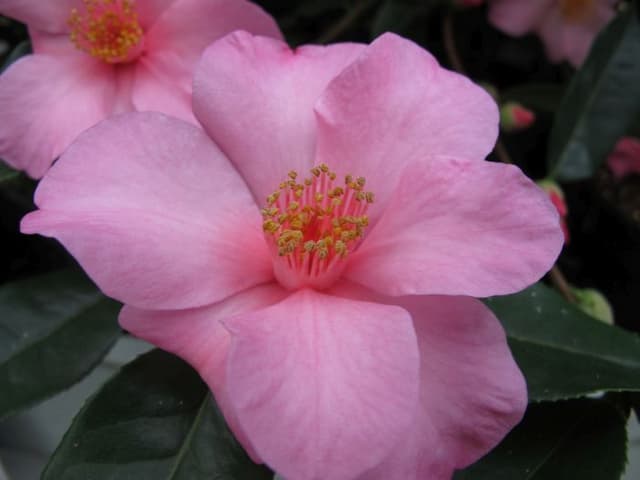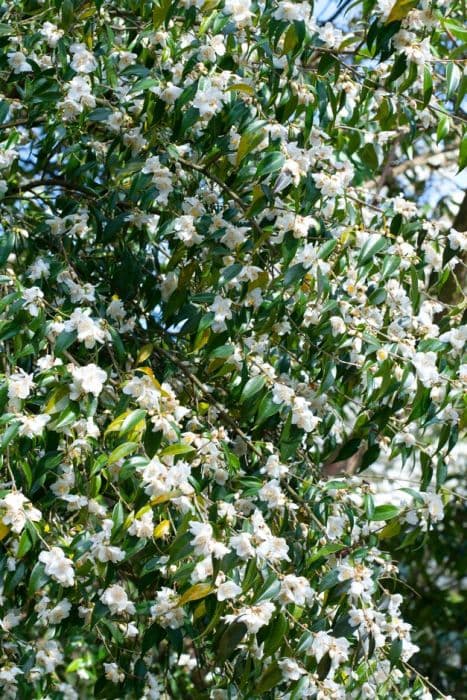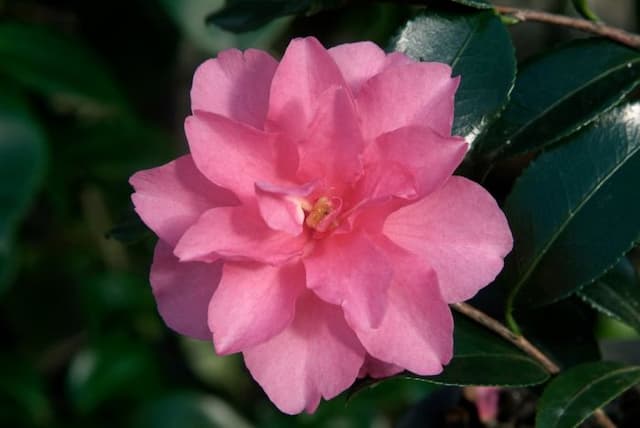Chinese Camellia Camellia grijsii

ABOUT
Camellia grijsii, commonly known as the Grey's camellia, is a plant with a visually appealing aesthetic. It is characterized by its lush, evergreen foliage, which displays glossy, dark green leaves. These leaves are typically oval-shaped with a slightly serrated edge, presenting a leathery texture that adds a rich, verdant backdrop year-round. The Grey's camellia blooms profusely, usually in the colder months when other plants have ceased flowering, thus adding color to the garden during a typically dull season. The flowers are beautifully formed, with a prominence that captures the eye. They exhibit a lovely shade of pale pink to almost white, with petals that are arranged in an overlapping fashion reminiscent of a rose. The center of the flower is accentuated by a cluster of contrasting yellow stamens, which add an additional layer of interest to the plant's blossoms. The overall shape of the Grey's camellia plant is often rounded, presenting a balanced and symmetrical appearance that makes it an excellent choice for ornamental purposes. Its refined and elegant blooms, coupled with the robustness of its foliage, make it a popular selection for gardens and landscapes seeking both beauty and endurance.
About this plant
 Names
NamesFamily
Theaceae
Synonyms
Chinese Camellia, Grijs' Camellia
Common names
Camellia amplexifolia, Camellia cuspidata, Thea grijsii.
 Toxicity
ToxicityTo humans
The toxicity of the Camellia grijsii, commonly known as Camellia to humans, is generally regarded as low. Typical members of the Camellia genus, including Camellia grijsii, are not known to be toxic to humans and are sometimes used in the production of teas, such as Camellia sinensis for green and black teas. However, it is always advisable to exercise caution and ensure accurate identification before any ingestion, as other non-edible plants can easily be mistaken for the Camellia species. There are no well-documented cases of poisoning from Camellia grijsii; hence, there is no specific list of symptoms associated with its toxicity to humans.
To pets
The toxicity of the Camellia grijsii, commonly known as Camellia to pets, is also considered low. This plant is not listed among those commonly known to be toxic to either cats or dogs. Therefore, ingestion of parts of this plant is not expected to cause significant symptoms of poisoning in pets. However, as with any non-food plant, consumption in large quantities may potentially cause mild gastrointestinal upset, such as vomiting or diarrhea, due to the ingestion of non-digestible plant matter. As a precaution, it is always wise to keep an eye on pets and prevent them from eating plants not intended for consumption.
 Characteristics
CharacteristicsLife cycle
Perennials
Foliage type
Evergreen
Color of leaves
Green
Flower color
White
Height
5-6 feet (1.5-1.8 meters)
Spread
5-7 feet (1.5-2.1 meters)
Plant type
Shrub
Hardiness zones
7
Native area
China
Benefits
 General Benefits
General Benefits- Ornamental Value: Camellia grijsii, commonly known as the Chinese camellia, is widely appreciated for its beautiful flowers, which enhance the visual appeal of gardens and landscapes.
- Habitat for Wildlife: The blooms provide nectar and pollen for bees and other pollinating insects, supporting local ecosystems.
- Cultural Significance: In certain cultures, camellias are symbols of love, affection, and admiration, making them meaningful additions to gardens.
- Shade Provider: As a shrub, it can offer shade to smaller plants and contribute to the layering effect in garden design.
- Soil Erosion Control: The root system helps to stabilize soil, reducing erosion in areas where this might be a concern.
- Privacy Screen: When planted in groups, these shrubs can form a dense screen that provides privacy and reduces noise pollution.
 Medical Properties
Medical Properties- Antioxidant: Camellia grijsii contains compounds that may have antioxidant properties, helping to neutralize free radicals in the body.
- Anti-inflammatory: Ingredients in this plant may possess anti-inflammatory effects, potentially reducing inflammation in the body.
- Antimicrobial: The plant has been observed to have antimicrobial activity against certain pathogens.
 Air-purifying Qualities
Air-purifying QualitiesThis plant is not specifically known for air purifying qualities.
 Other Uses
Other Uses- Camellia grijsii oil can be used in the cosmetic industry as a moisturizing component in creams and lotions, due to its hydrating properties.
- The seeds of the Camellia grijsii are sometimes used in jewelry or ornamentation, polished and strung into necklaces or bracelets.
- Wood from the Camellia grijsii plant can be crafted into small items such as buttons or carved trinkets, making use of its fine grain.
- The flowers of Camellia grijsii can be used in floral arrangements, adding elegance and fragrance to bouquets and centerpieces.
- Camellia grijsii petals may be candied and used as edible decorations on cakes and desserts, offering a unique visual appeal.
- The plant can be integrated into landscape design as a hedge or a privacy screen, due to its dense foliage and growth habit.
- Camellia grijsii leaves can be used as a natural mulch or compost material, enriching the soil as they decompose.
- Artisans may use the dried seed pods of Camellia grijsii in crafting decorative items, such as wreaths or potpourri.
- The essential oil extracted from the flowers of the Camellia grijsii could be an ingredient in natural perfumes, offering a unique scent profile.
- Ink can be made from the Camellia grijsii leaves, utilized by artists for drawing or as a pigment in traditional paintings.
Interesting Facts
 Feng Shui
Feng ShuiThe plant Camellia is not used in Feng Shui practice.
 Zodiac Sign Compitability
Zodiac Sign CompitabilityThe plant Camellia is not used in astrology practice.
 Plant Symbolism
Plant Symbolism- Admiration: The Camellia represents admiration and is often given to someone who is respected and looked up to.
- Perfection: With its perfect, intricate petals, the Camellia symbolizes the ideal or perfect beauty.
- Love: In some cultures, particularly in Japan, the Camellia flower is associated with love and affection.
- Longevity: Because the Camellia plant is evergreen and sturdy, it symbolizes longevity and enduring strength.
- Gratitude: Camellias can also express gratitude when given as a gift, symbolizing the giver's thanks.
 Water
WaterCamellia grijsii, commonly known as Grey-haired camellia, should be watered to keep the soil consistently moist but not soggy. Water this plant when the top inch of soil feels dry, usually about once a week, with about 1-2 gallons depending on the size of the plant and the environmental conditions. During the growing season in spring and summer, you may need to water more frequently, especially if the weather is particularly dry or hot. In the winter months, you can reduce watering as the plant's growth slows down. Always use room temperature water to avoid shocking the plant's roots.
 Light
LightGrey-haired camellia thrives in partial shade or dappled sunlight. It's best to place the plant in a location where it is protected from the intense afternoon sun, which can scorch its leaves. A spot that receives morning sunlight and afternoon shade would be ideal, ensuring that the plant gets sufficient light without being exposed to harsh conditions.
 Temperature
TemperatureGrey-haired camellia prefers temperatures between 60°F and 80°F for optimal growth. It can tolerate minimum temperatures down to about 20°F but should be protected from hard freezes. This plant is not well-suited for hot climates with temperatures consistently above 90°F, so ensure it has shade during the hottest part of the day.
 Pruning
PruningPrune Grey-haired camellia to maintain shape and promote healthy growth. The best time for pruning is immediately after it has finished blooming, which is typically by mid-spring. Remove any dead or weak branches, and shape the plant as desired. Pruning too late in the season can remove next year's buds, reducing the flowering potential.
 Cleaning
CleaningAs needed
 Soil
SoilThe best soil mix for the Camellia grijsii, commonly known as Chinese camellia, should be well-draining, rich in organic matter, and slightly acidic with a pH ranging from 5.5 to 6.5. A mix of two parts peat moss, one part perlite, and one part pine bark would be ideal, providing the necessary drainage and acidity.
 Repotting
RepottingChinese camellias should be repotted every 2-3 years to refresh the soil and encourage healthy growth. Choose a slightly larger pot to allow room for growth, but avoid repotting into a much larger pot as this can stress the plant.
 Humidity & Misting
Humidity & MistingChinese camellias thrive in environments with high humidity levels, preferably between 40% and 60%. These plants enjoy a moist atmosphere which can be achieved by using a humidity tray or a room humidifier.
 Suitable locations
Suitable locationsIndoor
Place Chinese camellia near bright window, avoid direct sun, keep soil moist.
Outdoor
Plant in partial shade, shelter from strong winds, mulch to retain moisture.
Hardiness zone
7-9 USDA
 Life cycle
Life cycleThe Camellia grijsii, commonly known as the Chinese camellia, starts its life as a seed, which requires well-drained, acidic soil, warmth, and moisture to germinate. After sprouting, the seedling goes through a juvenile stage, developing its root system and foliage. Growth accelerates as it enters the vegetative stage, where the plant focuses on leaf production and establishing a robust framework. The maturity stage follows, during which the Chinese camellia produces its characteristic fragrant flowers, typically during late winter or early spring. Pollination is often facilitated by insects, leading to the development of fruit that contains seeds, thereby completing the reproductive cycle. As a perennial, the Camellia grijsii can live for many years, seasonally flowering and setting seed.
 Propogation
PropogationPropogation time
Spring-Early Summer
The most popular method of propagation for Camellia grijsii, commonly known as the Grey Camellia, is via semi-hardwood cuttings. This technique is typically done in late summer when the plant's growth begins to slow, ensuring the cuttings have a good balance of mature and immature tissue. Cuttings about 4 to 6 inches long with several leaves are snipped from the parent plant. The lower leaves are removed, and the cut end is dipped in a rooting hormone to encourage root growth. The treated cutting is then planted in a well-draining soil mix, with the leafy top exposed. To retain moisture and create a humid environment, the pots are often covered with plastic and placed in indirect light. Roots usually form within several weeks, after which the new plant can be gradually acclimated to ambient conditions and eventually transplanted into the garden or a larger pot.









